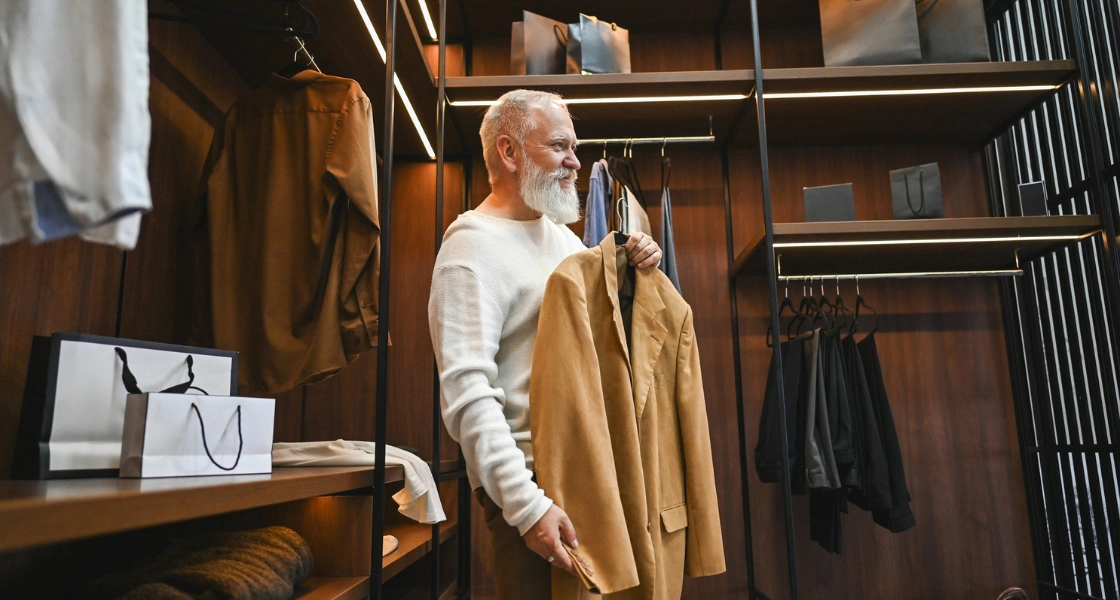Retail
Elevating the In-Store Experience: Strategies for Success in Luxury Retail
6 November 2025

The Importance of Human Interaction and Personalised Service
Human interaction remains the cornerstone of the luxury in-store experience, and it’s no coincidence that customer satisfaction in this sector is, on average, twice as high as in mainstream retail (source: Joël Hazan). However, the reality is more nuanced: fewer than 50% of luxury consumers surveyed report being fully satisfied with their in-store experience, and 11% even say they leave disappointed. No brand currently achieves a net satisfaction level above 50%.
This shortfall is partly due to the struggle of many brands to offer a digital shopping experience that matches the seamlessness of traditional e-commerce. This gap negatively impacts the perceived quality of service, particularly among younger customers. Generation Z, for instance, is significantly more demanding; one in five young people say their online experience falls short, compared to just one in ten baby boomers.
Within the physical store environment, the expertise and availability of sales staff are critical: 73% of luxury customers cite these factors as their main reason for choosing one brand over another (PwC 2024). Clients expect in-depth product knowledge, tailored advice, and the creation of a personalised relationship that extends far beyond a single transaction.
Luxury consumers invest in experiences, not just products. Sales staff, as true brand ambassadors, embody the story, values, and craftsmanship of the house. This human connection explains why 67% of luxury shoppers still prefer physical stores for their most significant purchases, despite the growing prominence of digital touchpoints.
Growing Expectations for Immersive and Memorable Experiences
Luxury in-store experiences now need to compete with digital ones in terms of creativity and engagement. Customers are seeking unique moments that leave a lasting impression and deepen their connection to the brand.
This desire for immersive experiences is evident in the increasing demand for spaces that tell a story, discovery workshops, private events, or exclusive services. 89% of millennial luxury consumers say the store’s atmosphere and aesthetic heavily influence their purchasing decisions.
The goal is to transform every store visit into a special moment where the client feels unique and valued. This experiential retail approach has become a key differentiator in a competitive landscape.
Balancing Tradition and Modernity
Luxury brands must walk the fine line between preserving their heritage and embracing modern technology. This duality represents one of the sector’s most complex challenges: how can innovation be integrated without compromising the brand’s identity?
Traditional craftsmanship, exclusivity, and time-honoured expertise are the foundations of perceived value in luxury products. At the same time, today’s consumers demand digital services, omnichannel connectivity, and technological innovations.
The solution lies in a hybrid approach that uses technology to enhance, rather than replace, traditional codes. This philosophy allows brands to create experiences that are both authentic and modern.
Strategies to Reinvent the In-Store Experience
Create an Immersive Atmosphere with Sensory Design
The layout of spaces and sensory design are the first emotional touchpoints in the customer journey. Every visual, auditory, and tactile element should contribute to creating a unique atmosphere that reflects the brand’s identity.
Visual storytelling transforms the store into a stage where the brand’s narrative comes to life. Lighting, materials, colours, and even ambient scents play a role in this immersive tale. A Deloitte study found that 60% of luxury consumers associate the store’s atmosphere with the perceived quality of products.
Spatial organisation should encourage the gradual discovery of collections, create private zones for personalised consultations, and showcase exceptional pieces. Thoughtful scenography naturally guides the customer journey towards a purchase.
Case in point
Le Louis, an immersive experience created by Louis Vuitton in Shanghai, reimagines store visits as an experiential journey blending art, craftsmanship, digital innovation, and personalised interactions. Initiatives like this elevate a store visit to a memorable experience, combining emotion, expertise, and innovation to foster customer loyalty. (Source)
Advanced Personalisation and Smart CRM Tools
Personalisation lies at the heart of today’s luxury experience. Advanced CRM tools now make it possible to anticipate client needs and offer tailored services from the moment they step into the store.
This personalisation is based on collecting and analysing behavioural data: purchase history, stylistic preferences, special occasions, and typical budgets. Brands that master this data-driven approach report a 25% increase in average basket size.
Equipped with tablets, sales associates can instantly access a customer’s full profile, suggest complementary products, and offer exclusive services tailored to their expectations. This seamless technology enhances the shopping experience without detracting from the human connection.
Integrating Technology to Enhance the Experience
Immersive technologies turn product discovery into an interactive experience. Touchscreen kiosks allow customers to browse entire collections, view intricate details, and explore the story behind creations.
Augmented reality is revolutionising try-ons, especially for jewellery and watches. Customers can visualise pieces on themselves without physical handling, compare options, and customise specific elements. This technology reduces decision-making time by 40%, while enriching the discovery experience.
Mobile apps connected to the in-store system extend the experience beyond the shop, enabling appointment booking, real-time stock checks, after-sales services, and invitations to exclusive events. This digital continuity strengthens long-term customer engagement.
Seamless Omnichannel for a Consistent Experience
In the luxury sector, omnichannel strategy demands absolute consistency across all touchpoints. Customers should experience the same level of quality, information, and service whether they are in-store, online, or using a mobile app.
This integration is achieved through cross-channel services: online reservations with in-store collection, real-time stock visibility, shared shopping carts across platforms, and unified interaction histories. Brands with strong omnichannel strategies report a 23% higher customer retention rate.
Sales associates can access a complete view of the client, including recent digital interactions, online searches, and stated preferences across all channels. This holistic perspective allows for optimal personalised service from the first in-store interaction.
Innovative Formats to Actively Engage Customers
Pop-up stores allow brands to test new concepts and host exclusive events in unique locations. These ephemeral spaces create a sense of urgency and exclusivity, which is particularly appealing to luxury consumers.
In-store workshops turn customers into active participants in the brand experience. Demonstrations of craftsmanship, personalisation sessions, or meetings with designers create memorable moments and strengthen emotional connections.
Private events for VIP clients, such as collection launches, tastings, or talks, transform the store into an exclusive club. These initiatives generate three times more customer engagement than traditional marketing campaigns.
Key stat
By 2026, Millennials and Generation Z will represent 75% of the luxury market. Meeting their expectations for immersive experiences, innovation, and personalisation is now essential for any brand looking to stay competitive. (Source: BCG)
Jewellery and Watch Sector Case Studies to Inspire Your Actions
Personalisation Workshops and Educational Experiences
The jewellery and watch sectors excel in creating immersive educational experiences. Brands host discovery workshops that allow clients to learn about the creation process, from material selection to final polishing.
Cartier, for example, offers dedicated personalisation spaces in some boutiques where clients can engrave their initials, choose gemstones, or modify aesthetic details.
Live horology demonstrations showcase the complexity of watch mechanisms and celebrate artisanal expertise. Clients can witness the assembly of a movement or the placement of a dial, turning a purchase into an enriching cultural experience.
Educational Experiences on Materials and Watchmaking
Educating clients has become a key differentiator in a sector where technical details can be intimidating for newcomers. Educational spaces explain the properties of precious metals, the formation of gemstones, or technological innovations.
Interactive tools allow clients to compare the durability of different materials, visualise watch mechanisms in motion, or explore the history of iconic complications. This educational approach reassures clients in their choices and highlights the value behind the price.
Digital authenticity certificates, accessible via QR codes, provide the complete history of each piece: origin of materials, manufacturing stages, and quality checks. This transparency boosts customer trust by 45%, according to a recent industry study.
“Brands that can stage immersive experiences (phygital, sensory, narrative) and create bridges between their universes (fashion, beauty, hospitality…) will stand out. Young consumers favour rich, immersive content, from runway videos and artisan gestures to sustainability efforts.”
— Cécile Lejeune, President of Kantar Insights France
Measuring Impact and Sustaining Success
To ensure the long-term success of in-store transformation in the luxury sector, it’s essential to implement structured methods for evaluation, ongoing improvement, and team development.
Collecting and Analysing Customer Feedback
Continuously improving the customer experience requires regular, systematic collection of feedback. Digital tools (tablets, QR codes) in stores facilitate real-time impressions, while post-visit surveys provide deeper insights into expectations and friction points. This dual approach – immediate and detailed – offers a complete picture of areas for improvement. Moreover, leveraging this feedback demonstrates the brand’s commitment to excellence while directly informing service enhancements.
Monitoring Performance with Tailored KPIs
Regular analysis of key performance indicators (KPIs) helps objectively assess the effectiveness of initiatives. Metrics to prioritise include:
- Store conversion rates, a direct measure of how the experience drives purchases;
- The average basket size, reflecting the quality of advice and the ability to showcase the offer;
- Retention indicators: visit frequency, Net Promoter Score (NPS), return rate, and engagement with connected services;
- Digital in-store experience data, such as time spent and interaction with technological tools.
This data-driven approach enables continuous adaptation and optimisation of experiential strategies.
Investing in Ongoing Team Training
Service excellence cannot be maintained without continuous investment in employee development. Training programmes should focus on product expertise, consultative selling techniques, and mastery of digital tools. This effort ensures adherence to key processes and elevates the level of advice offered, a critical factor in customer satisfaction and loyalty. Over time, brands that prioritise team skill-building observe overall improvement in commercial performance.
By integrating customer feedback, performance analysis, and ongoing training into their management model, luxury retailers build a solid foundation for consistently enhancing and evolving the experiences they offer.
The success of your experiential transformation depends on adopting high-performance technological tools that amplify your craftsmanship while preserving its essence. Integrated solutions enable personalisation at every touchpoint, streamline internal processes, and create unforgettable experiences that foster loyalty among discerning customers.
This shift towards enhanced experiences represents a strategic investment essential for maintaining your competitive edge. Brands that intelligently combine tradition and innovation create exceptional retail spaces that drive growth and lasting customer relationships.
The challenge is to turn every store visit into a special moment, where service excellence and technological innovation come together to create the magic of contemporary luxury.
Discover how to transform your stores into unforgettable experiences with the power of technology:Luxury Retail Trends 2025.



